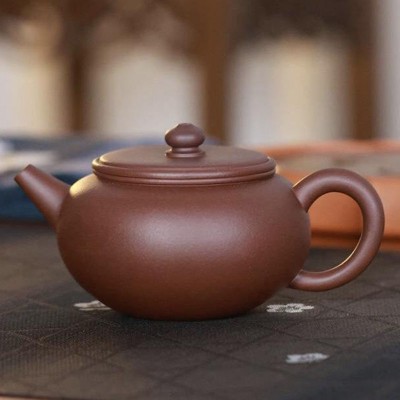


"Suyuan" refers to the simple and unadorned appearance of this type of yixing teapot, with smooth and rounded lines and no patterns or decorations. The design philosophy of the "Suyuan" purple clay teapot is to pursue a natural, simple and pure aesthetic, allowing the taste and aroma of the tea to be fully displayed, hence the name "Suyuan".
 Delivery
Delivery
Free shipping within 1 to 3 days. ETA:5-7 days
 Returns
Returns
Within 28 days after delivery date.
 Security
Security
SSL | GDRP used to ensure information security.
Guarantee safe & secure checkout
Data sheet
I recently added a Yixing teapot to my collection and it has completely transformed my tea ritual. The tea brewed in it has a natural sweetness and a smooth finish that I find absolutely delightful. It's a must-have for anyone who truly appreciates the art of tea.
"Julun" yixing teapot- this "Julun" zisha teapot is designed for practicality, with a spout that ensures smooth water flow and a handle that is easy to grip. The lid is also uniquely designed for easy removal. Despite its distinctive and eye-catching appearance, the "Julun" teapot is a functional and practical utensil that is highly valued by tea enthusiasts for its ability to brew tea effectively and efficiently. Its unique shape allows tea leaves to fully expand, releasing more aroma and flavor. The name "JuLun" comes from its shape, which resembles an upside-down cartwheel. This teapot is not only aesthetically pleasing but also highly functional, making it a popular choice among tea lovers and collectors.
"Jizhi" yixing teapot has a straight cylindrical body with a shoulder, short neck, and straight spout. The handle is free-flowing and ear-shaped, while the lid fits tightly. The bottom of the pot is neatly crafted with exquisite workmanship. The overall design of the pot displays a strong contrast between thick and thin lines, as well as between straight and curved lines, giving it a deep, simple, and powerful temperament. At the same time, it also exudes a sense of elegance and grace. It seems that the "Jizhi" teapot conveys a spirit of honesty and justice, daring to advise others.
"Meirenjian" yixing teapot resembles an ancient woman, dignified and lovely, with a hint of palace elegance and grace, yet without losing the charm of a young lady. The shape is full and elegant, mainly reflecting the roundness of the pot body. The pot cover and the pot body seem to be integrated without any gaps. When touched by hand, one can feel its warmth.
"Hehuan" means "all happy",the zisha art master- "Mansheng" was inspired by the beautiful and harmonious sound of the cymbals coming together during the celebration. He believed that this sound brought joy and happiness to people, so he used the shape of the cymbals as a model to design the Hehuan teapot. He named it after the joyous sound they made when struck together, and the teapot's unique shape and design symbolize the harmony and beauty of life.
"Shipiao" Yixing teapot- this zisha teapot is a traditional Chinese tea set characterized by its gourd-like or calabash-like shape, with a small top and large bottom, a sturdy and short spout, and a pyramid-shaped body that exudes elegance. Made from high-quality purple clay material, this teapot is known for its hardness and durability, as well as its stable and easy-to-use design. The short and powerful straight spout ensures a smooth and steady flow of water, while the pyramid-shaped body adds a touch of sophistication to any tea ceremony.
"Handui", also known as the bell of the Han Dynasty, is a type of instrument.
"Shipiao" Yixing teapot- this zisha teapot is a traditional Chinese tea set characterized by its gourd-like or calabash-like shape, with a small top and large bottom, a sturdy and short spout, and a pyramid-shaped body that exudes elegance. Made from high-quality purple clay material, this teapot is known for its hardness and durability, as well as its stable and easy-to-use design. The short and powerful straight spout ensures a smooth and steady flow of water, while the pyramid-shaped body adds a touch of sophistication to any tea ceremony.
This is a type of teapot shape that was created during the Yuan Dynasty. It's called "SengMao" because the shape of the spout resembles a monk's hat. The shape of the teapot has a raised lip, a low front and high back, a duck-bill shaped spout, and the lid rests inside the lip. It has a narrow neck, a bulging belly, a circular foot, and a curved handle, and is characterized by a strong ethnic minority style.. Initially, it was used exclusively for Buddhist monks to drink tea, but over time it gradually became a classic shape of the square zisha teapot.
"Hanwa" Yixing teapot is shaped like a cylindrical jar, which appears straight up and down, but has an arched middle that gives it a strong tension. The lid is a large, slightly bulging and curved circle, with a bridge-shaped knob on top that slopes gently. The straight spout is of moderate length, while the ear-shaped handle is slightly flattened in the middle. Both the spout and handle are polygonal, providing visual changes and a classic combination of square and round in art.
"De" means morality,"zhong" means "bell",The bell-shaped lid and body of this zisha teapot symbolize a person with noble character, frugality, and simplicity. Owning this teapot is seen as a sign of being a true gentleman, as it represents the values of humility and refinement.
"Linghua" Yxing teapot is adorned with diamond-shaped patterns all over its body, with the lid seamlessly integrated into the design. The lid is composed of six petals that are symmetrically arranged, and the edges are sharply defined, creating a beautiful and charming appearance. The teapot design evolved from the Line Yun teapot, with the bridge handle blending in with the diamond petals. The spout is shaped like a diamond flower, with a natural curve that is easy to hold. A waistband is tied around the center of the teapot, and the diamond lines intersect perfectly from top to bottom. The lid can be rotated to fit securely on any of the six sides, showcasing the exquisite craftsmanship of this teapot.
The "Dabin-Ruyi" is a classic Yixing teapot designed and made for Dabin during the Ming Dynasty. Dabin designed this teapot with the meaning of "everything goes as desired" .The lid is convex and serves as a cover. The lid is decorated with four symmetrical Ruyi patterns, with a thickness of about 1 millimeter and exquisite craftsmanship. The knob is flat and round, and there is an air hole in the center of the lid that is connected to the knob. The hole in the lid is large, while the hole in the knob is small and round, with precise workmanship. The "sanwan" spout are inwardly curved, giving the teapot a dignified and refined appearance. The Dabin-Ruyi teapot is simple and elegant, with a grandeur that is not overwhelming, fully reflecting the style of Dabin's teapot making.
"Shipiao" Yixing teapot- this zisha teapot is a traditional Chinese tea set characterized by its gourd-like or calabash-like shape, with a small top and large bottom, a sturdy and short spout, and a pyramid-shaped body that exudes elegance. Made from high-quality purple clay material, this teapot is known for its hardness and durability, as well as its stable and easy-to-use design. The short and powerful straight spout ensures a smooth and steady flow of water, while the pyramid-shaped body adds a touch of sophistication to any tea ceremony.
A flattened persimmon-shaped teapot is called a "Short Pan," a slightly taller and flattened spherical-shaped teapot is called a "Medium Pan," and a teapot with a taller and pear-shaped body is called a "Tall Pan." When their daughters got married, they would give a Pan teapot as part of their dowry, hoping that their daughters would be able to live a prosperous life like "Pan Shicheng" who the inventor of the "pan" teapot. teapots that are passed down as part of the dowry are not necessarily used for brewing tea, but can also be placed on dressing tables to hold hair oil. After the female owner passes away, they are often used as burial objects to show gratitude to her family for raising her.
"Hanwa" Yixing teapot is shaped like a cylindrical jar, which appears straight up and down, but has an arched middle that gives it a strong tension. The lid is a large, slightly bulging and curved circle, with a bridge-shaped knob on top that slopes gently. The straight spout is of moderate length, while the ear-shaped handle is slightly flattened in the middle. Both the spout and handle are polygonal, providing visual changes and a classic combination of square and round in art.
"Shipiao" Yixing teapot- this zisha teapot is a traditional Chinese tea set characterized by its gourd-like or calabash-like shape, with a small top and large bottom, a sturdy and short spout, and a pyramid-shaped body that exudes elegance. Made from high-quality purple clay material, this teapot is known for its hardness and durability, as well as its stable and easy-to-use design. The short and powerful straight spout ensures a smooth and steady flow of water, while the pyramid-shaped body adds a touch of sophistication to any tea ceremony.
NOTICE : Cookies ensure the smooth running of our services and improve user experience,Using these, you accept the use of cookies. Learn More.